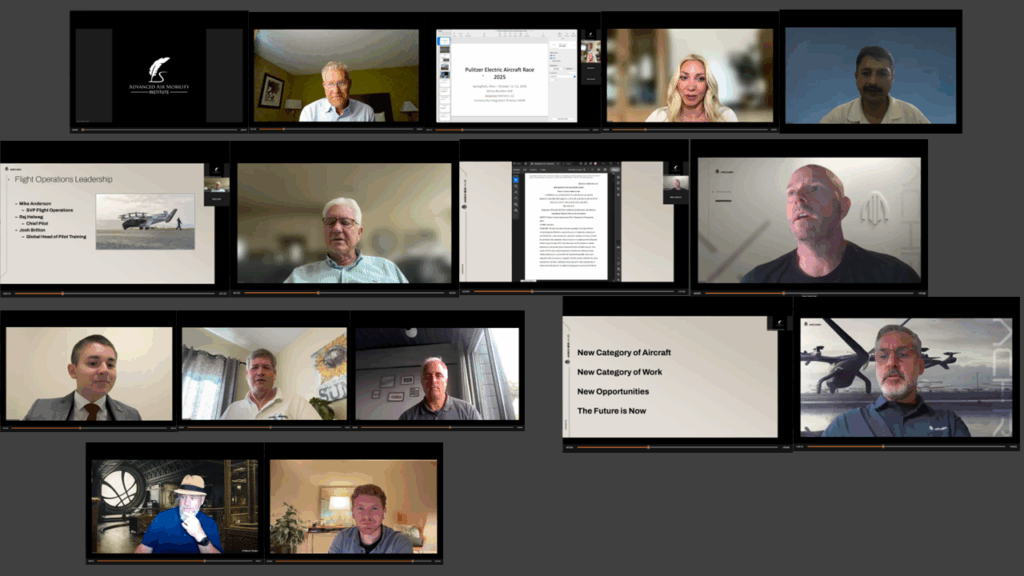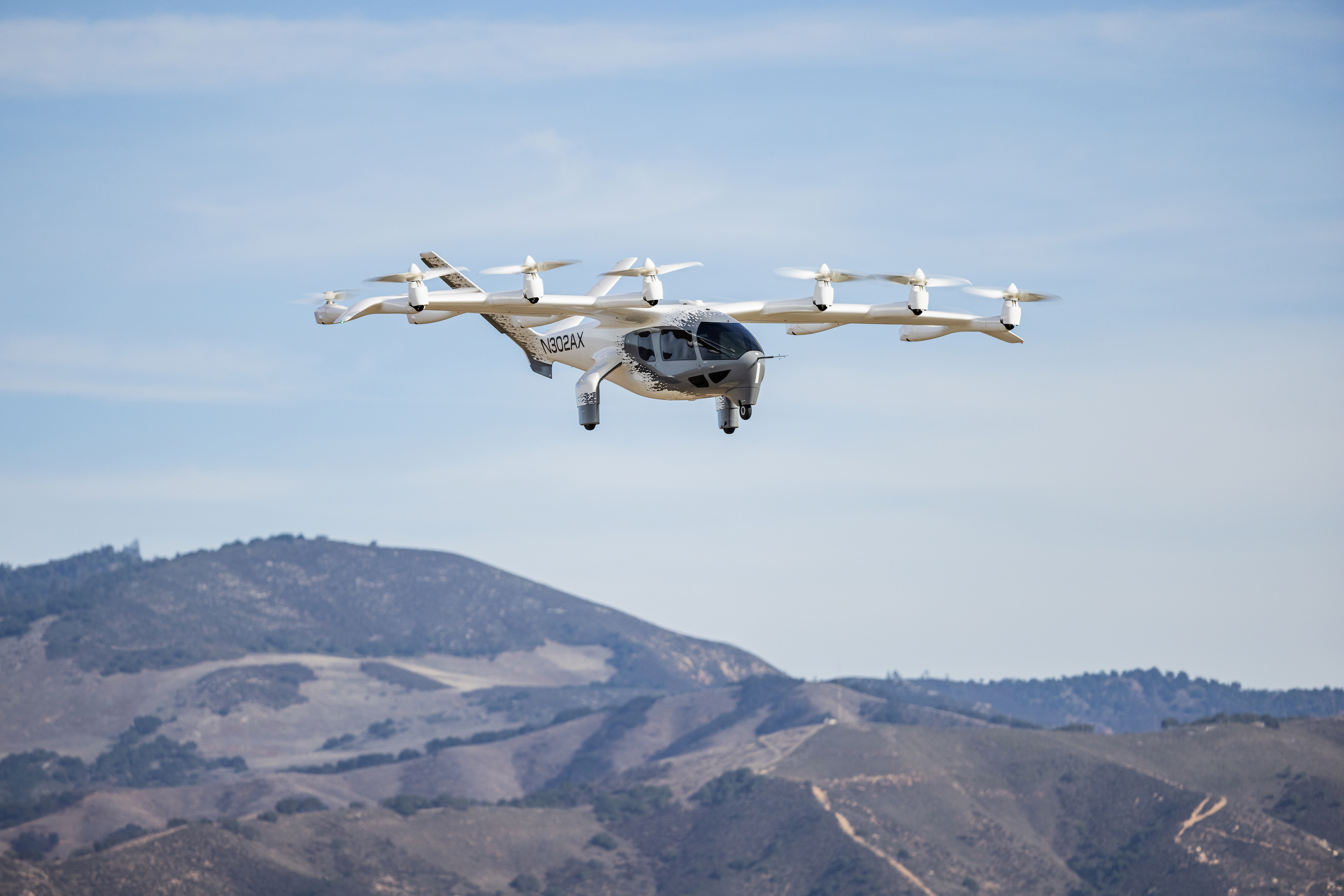By: Chris “SPinRH” Penningroth, Advanced Air Mobility Institute, European Region Training Officer
On August 29, 2025, the Advanced Air Mobility Institute (AAMI) hosted its inaugural industry roundtable on flight instruction for powered lift and advanced air mobility (AAM) aircraft, a milestone moment for an industry on the cusp of transformation.
More than sixty participants joined the virtual event, representing aircraft manufacturers, academia, weather intelligence firms, infrastructure experts and pilot training organizations. The discussions reflected the growing consensus that powered lift training is not just a new chapter in aviation…it’s a new book altogether.
More than a summary of insights, this is a behind-the-scenes look into where the visionaries of electric vertical takeoff and landing (eVTOL), air infrastructure, mental health advocacy and pilot training see the industry heading…and what it truly takes to build an ecosystem ready for the next era of flight.
The Pulitzer Electric Air Race: Electrifying the Skies
The session opened with the announcement of the Pulitzer Electric Air Race, a symbolic milestone marking the next century in electric aviation. More than just a race, it signaled the industry’s determination to move from concepts to operational realities in performance, logistics, and pilot readiness.
Scheduled for October 10-13, 2025 in Springfield, Ohio, and organized by AAMI, the Pulitzer Electric Air Race highlights the synergy between legacy achievements and future progress. This event, sanctioned by the National Aeronautic Association and supported by interactive simulation partners, will become a proving ground for electric propulsion and flight training under real-world and virtual conditions. As the race brings together new entrants and established players, it embodies the sector’s emphasis on measurable, public-facing advances.
Archer Aviation’s Midnight: Training for the Real World
Archer Aviation headlined the keynote segment with their vision for AAM, anchored by the Midnight aircraft, an eVTOL that is not just an engineering marvel but a training challenge. With plans to launch in Abu Dhabi, and deep connections to major US city networks like Los Angeles, Archer’s approach interweaves technical innovation with regulatory compliance; including Part 135, 141, and 142 training approvals.
Senior Vice President Mike Anderson and his team outlined Archer’s vision for a workforce ready to launch AAM passenger operations by 2026. Their approach blends airline-level discipline with urban air mobility agility to bridge the worlds of fixed-wing and rotary-wing aviation. As Chief Pilot Raj Helwig noted, “This isn’t about stick-and-rudder flying—it’s about command-driven, high-trust operations in an entirely new airspace.”
Critically, Archer’s Josh Britton addressed the shifting regulatory landscape: The upcoming Part 194 regulations and powered-lift airman standards mean today’s pilot candidates must bring a hybrid skillset across fixed- and rotary-wing categories, with rigorous cross-training. Their simulator-heavy programs are designed for rapid upskilling, with pilots expected to master both traditional and cutting-edge operational maneuvers, including urban air corridors and highly automated controls. The theme: The future pilot is as much a systems manager as a stick-and-rudder aviator.
Fixed- and Rotary-Wing Perspectives: Building Bridges

Industry voices emphasized that AAM is not “Just another type of aircraft.” The fixed-wing perspective, presented by Embry-Riddle Aeronautical University’s Henry Stanley, touched on how AAM redefines professional opportunities for pilots, potentially resolving the classic dilemma of geographic and financial barriers to advancement.
From the rotary-wing side, Indian Army veteran Shailesh Chaturvedi mapped out the operational spectrum: Today’s piloted flights, evolving toward semi-autonomous systems, and eventually fully supervisor-in-the-loop operations. The learning curve involves not just traditional skills but the ability to respond to cyber incidents, manage high-density airspace and transition between manual and supervisory roles as autonomy matures.
Organizational Proactivity: Flight Instructors as Catalysts
I spotlighted flight instructors’ pivotal roles in navigating regulatory uncertainty. As OEMs take increasing control over training curricula, instructors must bridge gaps by leveraging industry best practices and even generative AI innovation to keep material current and impactful. The comparison to vendor-neutral instructor standards and certifications in IT underscored a key takeaway: Resilient, agile training programs will define safe AAM adoption.
Infrastructure and Weather: The Unseen Backbone
Rex Alexander of Five-Alpha addressed the crucial, often overlooked, question of infrastructure. From heliport definition standards to case studies where regulatory gaps led to incidents, the message was clear: Infrastructure safety is a direct product of training and standards adherence. Instructors and operators must become stewards of best practices, empowering pilots to identify and act on deficiencies before they result in accidents. Alexander emphasized that training must teach pilots to recognize infrastructure risk as much as aerodynamic risk.
Similarly, Don Berchoff of TruWeather Solutions drove home the importance of weather adaptation. Traditional observation networks do not meet AAM’s low-altitude urban complexity. Berchoff made a compelling case for distributed low-altitude weather sensing to fill the “Data desert” between airports. Distributed IoT weather sensors, advanced LIDAR and vertical profiling are the new frontier to ensure pilots have actionable insights in microclimates, critical for risk management and operational continuity.
Mental Health and Duty Cycles: The Human Factor
Pilot Mental Health Campaign founder Brian Bomhoff’s advocacy for pilot mental health reminded the community that sustainable AAM operations will depend as much on psychological readiness as technical proficiency. He exposed a hidden crisis: More than half of collegiate pilots feel they cannot seek help for fear of certificate loss. As AAM jobs present new pressures including direct passenger interaction, rapid turnarounds and multi-leg duty cycles, addressing regulatory and cultural blocks to care will be central to long-term sector well-being. Fatigue management also takes on a new meaning in short-hop, high-cycle AAM operations, demanding smart scheduling and realistic duty-day limits.
Panel Insights: Realities, Risks, and Social Acceptance
The panel phase reinforced a core truth: Successful AAM isn’t just about aircraft or airspace. It’s about winning hearts, minds and regulatory buy-in. Industry speakers highlighted critical gaps: Integrating AAM curricula into schools, ensuring public acceptance of neighborhood vertiports and managing the intersection between TSA security needs and seamless passenger flows.
Several panelists stressed the need to maintain “Corporate memory,” the nuanced knowledge pilots bring about weather, handling and airspace, which risks being diluted as we move toward remote and automated operations. Social acceptance emerged as a crucible. Community buy-in and mentoring will ensure AAM’s sustainability and pipeline of engaged, motivated aviators.
International Perspectives: Collaboration Across Borders
A global view added layers of perspective. New Zealand’s Sacha Wetzel reminded participants that skepticism can be addressed by transparent OEM-customer engagement, not just marketing. Cross-border information-sharing, from India’s rotary-wing traditions to U.S. airspace innovation, will be essential for global harmonization and safety.
From Vision to Reality
In one morning, the roundtable encapsulated aviation’s next great transition: From wings and rotors to something altogether new. As moderator Keith Sarich summed up, “Advanced air mobility isn’t waiting for the future—it’s already taxiing for takeoff.”
In the end, AAMI’s roundtable left no doubt: The pathway to widespread AAM adoption is complex, collaborative and exhilarating. From race tracks in Ohio to simulated control rooms and vertiport boardrooms, the industry is defining best practices that blend legacy wisdom with next-gen technology. Flight instructors, regulatory champions, infrastructure experts and mental health advocates are the fabric of this ecosystem, each evolving their practice for the coming wave.
As future-focused headlines spotlight the Midnight aircraft, world-record electric races, and automated air routes, the essential work happens behind the scenes, where passionate professionals gather, debate and shape the future from Midnight to Mach 2.

